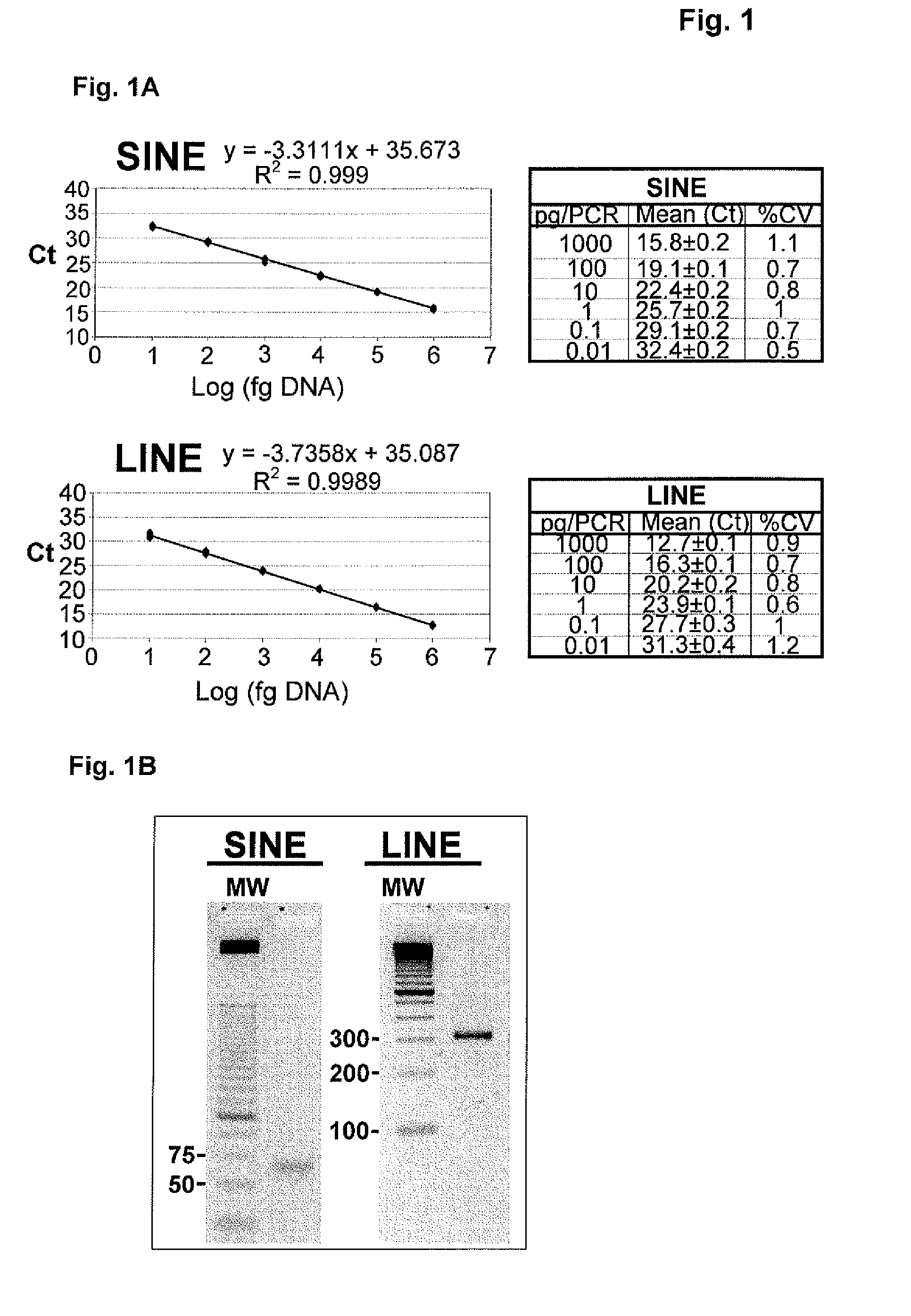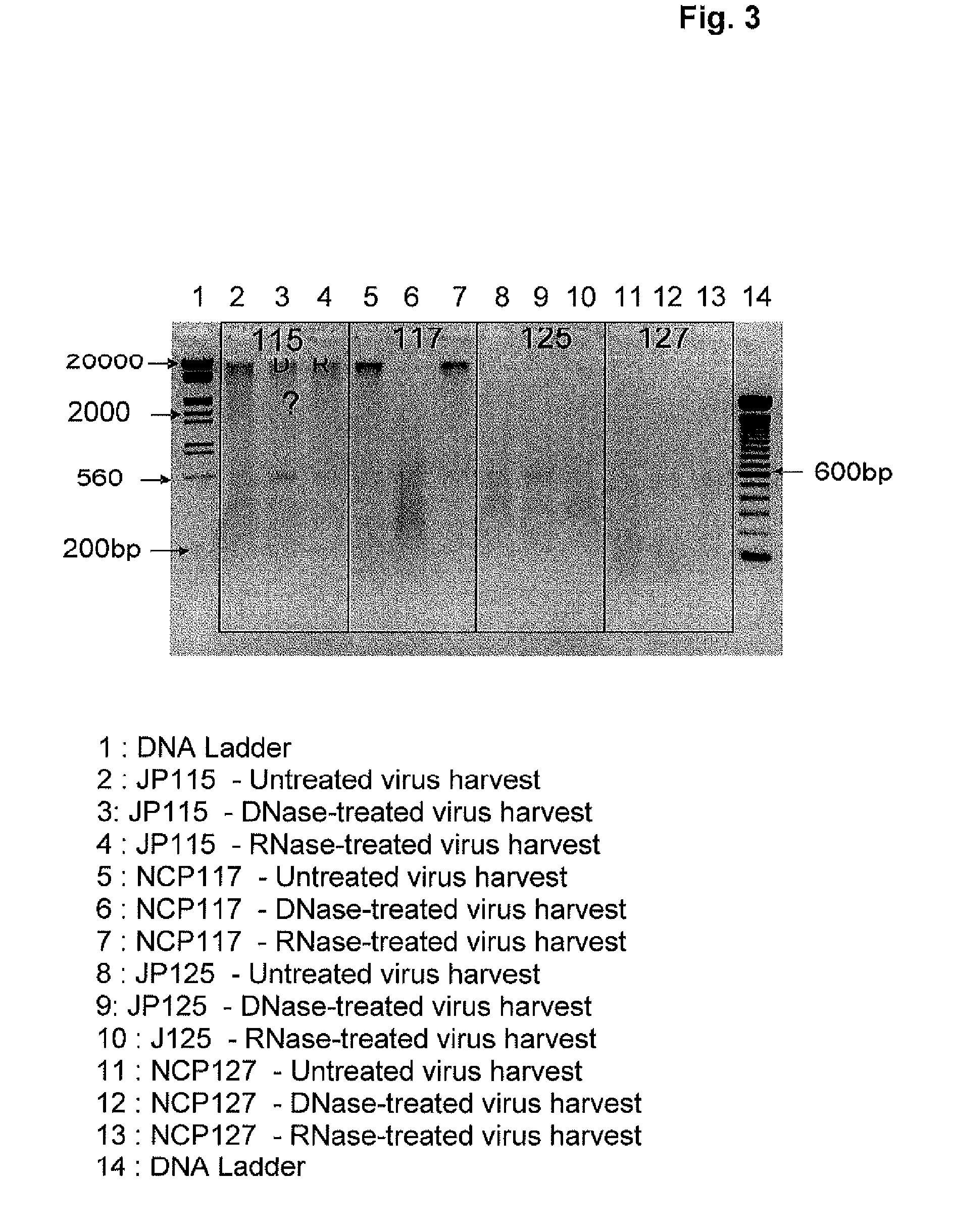Novel method
a cell culture and cell technology, applied in the field of cell culture-based methods, can solve the problems of contaminated cells, cellular components, and low flexibility of egg-based processes, and achieve the effects of high virus yield, low residual dna content, and high dna fragmentation
- Summary
- Abstract
- Description
- Claims
- Application Information
AI Technical Summary
Benefits of technology
Problems solved by technology
Method used
Image
Examples
example 1
Production of Influenza Virus in MDCK Cells in the Presence of One Step of DNA Degradation Performed with an Endonuclease During the Virus Isolation Phase (JP115-Jiangsu B Strain, NCP117—New Calcdonia A Strain)
1. Virus Multiplication
[0153]The MDCK adherent cells were grown on microcarriers in perfusion culture mode in a 20 liter stirred-bioreactor scale at 36.5° C. After the growth phase, once the appropriate cell density was reached (above 7×106 cells / ml), cells were inoculated with Influenza virus (Multiplicity of Infection of 1×10−6) in perfusion mode and the temperature was switched to 33° C. The virus was harvested by collecting the cell culture medium by perfusion at days 3 and 4 post-inoculation (JP115) or at days 3, 4 and 5 post-inoculation (NCP117). The perfusion harvests were pooled and stored at a temperature ranging from 2 to 8° C. until further processing.
[0154]a) The viral harvest was clarified on a filtration train composed of three different depth f...
example 2
Production of Influenza Virus in MDCK Cells in the Presence of Multiple Steps of DNA Degradation Performed with an an Endonuclease and a DNA Alkylating Agent
[0155]1. Virus multiplication
[0156]The MDCK adherent cells were grown on microcarriers in a perfusion culture mode in a 20 liter stirred bioreactor scale at 36.5° C. After the growth phase, once the appropriate cell density was reached (above 7×106 cells / ml), cells were infected with Influenza virus (Multiplicity of Infection of 1×10−6) in a perfusion mode and temperature was switched to 33° C. Benzonase™ (Merck) was added according to one of the following conditions:
(i) at a final concentration of 1.5 Units / ml in the perfusion at days 3 and day 4 post-inoculation (JP125—Jiangsu B strain, NCP127—New Calcdonia A strain, DFC1AFA002—New Calcdonia A strain, DFC2AFA001—New York A strain and DFC3APA002—Jiangsu B strain),
(ii) at a final concentration of 1 Unit / ml in the bioreactor at day 1, 2, 3 and 4 post-inoculation (B005—New York A ...
example 3
Methods for Measuring the Size and the Amount of Residual DNA
[0165]1. DNA Sample Treatment for DNA from MDCK Cells
[0166]Viral harvests or purified bulks (30 ml), as indicated, were first treated with 100 μg / ml proteinase K in the presence of 0.1% SDS, at 55° C. overnight, followed by a standard phenol / chloroform extraction. The resulting solution was then concentrated using a Centriplus centrifugal filter device (Millipore, YM-30 4422). Next, the sample was treated with 5% RNase (Roche) for 90 minutes at 37° C., followed by a second concentration step using a Microcon centrifugal filter device (Millipore, YM-50 42416). The final volume was split into two fractions, the first one aimed at DNA visualization by agarose gel and Southern-blot analysis and the second one intended for a Q-PCR quantification.
2. DNA Sample Treatment for DNA from EB66® Cells
[0167]Purified bulks (4 ml) were treated with 200 μg / ml proteinase K in the presence of 0.1% SDS, at 55° C. for 2 hours. The DNA is then ...
PUM
| Property | Measurement | Unit |
|---|---|---|
| Mass | aaaaa | aaaaa |
| Mass | aaaaa | aaaaa |
| Mass | aaaaa | aaaaa |
Abstract
Description
Claims
Application Information
 Login to View More
Login to View More - R&D
- Intellectual Property
- Life Sciences
- Materials
- Tech Scout
- Unparalleled Data Quality
- Higher Quality Content
- 60% Fewer Hallucinations
Browse by: Latest US Patents, China's latest patents, Technical Efficacy Thesaurus, Application Domain, Technology Topic, Popular Technical Reports.
© 2025 PatSnap. All rights reserved.Legal|Privacy policy|Modern Slavery Act Transparency Statement|Sitemap|About US| Contact US: help@patsnap.com



